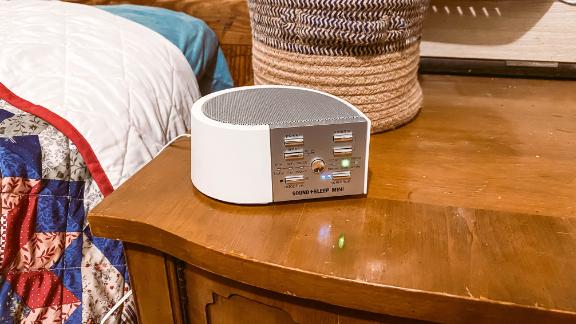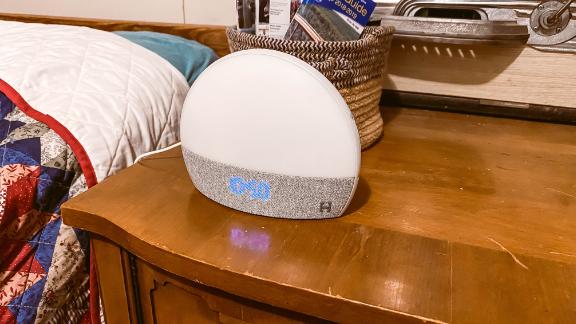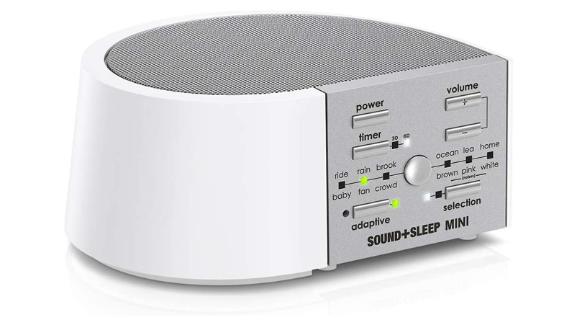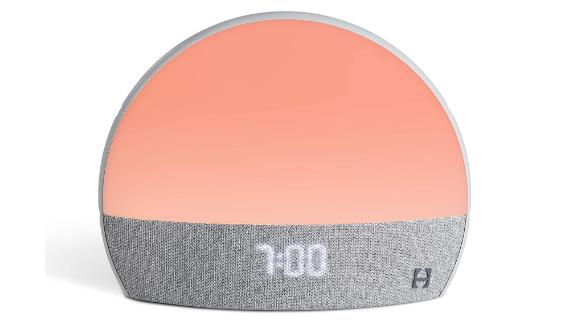Noise can affect sleep for better or worse. White noise machines that emit just that — consistent noise — fall squarely in the “better” category. Constant white noise, like the kind produced by a white noise machine, has been shown to improve sleep quality because it helps mask sudden bursts of noise that may help some people more easily fall and stay asleep.
“White noise machine” is a blanket term that consists of basic machines that do the bare minimum (that is, emit white noise at varying volumes) to high-end pieces of tech that feature lights, automations and more. We tested eight top-rated machines, aiming for devices with a variety of sound options and great volume control for heavy and light sleepers alike. After two months, two stood above the rest:
Best sound machine overall: Sound+Sleep Mini ($65.63; amazon.com)

If you’re looking for a plethora of sounds to soothe you into sleep, the Sound+Sleep Mini will fit the bill with more than 48 tracks across 12 categories that range from the standard (white and pink noise) to the environmental (rain or ocean).
It would be a lot to list out 48 individual sounds, but here are a few highlights: Fireplace inspired the same warm, cozy vibe you get from a nearby crackling fireplace. Crickets with light rain filled the space with a medley of natural sounds, transporting us to a relaxing night outdoors (without any of the actual bugs and rain). All of the soundscapes under the “Crowd” category reminded us of when we could go out to a cafe with a laptop. With such an array of sounds — more than any other we tested — it prevented the mundanity that we experienced hearing the same sounds over and over with most of the other machines.
Speaking of mundanity, some sound machines, like the SoundSpa Portable and the Hatch Rest, have somewhat short soundtracks where you can recognize where the loop restarts. Sometimes, heating that tiny glitch hearing when a soundscape has restarted made it more difficult for us to relax. With the Sound+Sleep Mini, we never recognized those repeats.
Of course, if you can’t set the volume just right, you’ll be adjusting it all night. And few devices offered as many gradations between whisper quiet and booming loud as the Mini. You can thank the high-fidelity 2.5-inch speakers for the latter. It’s not necessarily room filing, but it does pack a punch on the audio scale and can sound bigger than it appears — helping to better mask ambient noises that could disturb sleep. The Sound+Sleep Mini features an upfiring speaker on the top, so it’s directionally pushing the sound upward. Thanks to its comparatively wider volume gradient, we were easily able to pick out a precise volume that we preferred.
The device also features an adaptive sound mode, wherein a built-in microphone detects environmental sounds and increases the volume in an attempt to cover them up. We tested this by clapping near the machine, then farther away, and finally, while having people converse loudly in the next room. We only noticed a significant volume change when the sounds originated in the same room as the machine. So if you have a noisy roommate, it could help, but with loud neighbors, you may have to change the volume yourself.
The sound quality is decent. The Mini is more than capable of reaching high and low notes, which greatly helped our immersion once we closed our eyes and listened to each track. It handled the tracks better than most of the others we tested, and there wasn’t a tinny quality to the sound, even when the pitches rose. Still, the Hatch Restore, which is nearly double the price, bested the Sound+Sleep Mini in this regard. The sound it puts out has more depth, and is produced with a much higher level of clarity, whereas the Sound+Sleep Mini is less crisp overall.
The Sound+Sleep Mini, as the name may suggest, is a compact device, with an asymmetrical teardrop shape and a flat top, upon which the speaker resides. Like most of the sound machines we tested, it’s a cinch to set up. All you have to do is plug the included power cable into the bottom of the Mini and then plug that into the wall. Alternatively, you can insert 4 AA batteries beneath a bottom panel.
The device’s controls are laid over a flat surface on the side. They may look complex, but they’re not. A central circular button cycles through each category while another button, labeled “selection”, controls which track is playing within that category. LED lights inside this panel intuitively indicate exactly which selection is currently playing. There’s even a snooze timer with 30-, 60- and 90-minute options. This particular timer is unique, lowering the volume gradually as it nears its end. It’s not a feature we often noticed, as we were asleep before it kicked in. The LED lights fade out, too, so as not to distract you — although, they didn’t distract us at their full brightness, either.
On the side near the controls are two audio ports: one is for audio input if you want to use the Mini as a speaker. The other is a headphone jack, a feature we wish more machines included. Using this option, you can become even more immersed in your selection of choice. The sound quality is even a little better with headphones on if you have a half-decent pair.
Overall, the Sound+Sleep Mini has everything you’d want in a sound machine. It comes with a multitude of soundtracks, expansive volume control and a timer for dozing off. In terms of design, it’s a sleek piece that will go well on your nightstand with controls that you’ll learn in a flash. At $65.63, it isn’t the cheapest option out there, but its multitude of features can appease any sleeper.
The upgrade pick: Hatch Restore ($129.99; amazon.com)

Boasting a companion app, class-leading soundscapes, routines that help you fall asleep and wake up easier, along with several lighting options (to, again, lull you to sleep or gently wake you up), the Hatch Restore is the ultimate sleep gadget. It also comes at a premium price — $129.99. But when you put all its functionalities together, that cost is justified.
We were blown away by the Restore’s 31 sound choices, consisting of soundscapes, music and narrated selections for meditation and rest. The tracks are high-quality in both fidelity and composition. Ocean Sounds in Maine, for example, consists of waves that you can hear splashing underfoot, with overtones of oceanic bird calls and an implacable yet soothing hum. If you close your eyes, then any one of the Restore’s soundscapes can whisk you away to another place. Even better, the tracks were long enough for us to fall to sleep before they ended and started over the loop, lasting longer than those of any other machine we tested. Oceans of Maine is a whopping 45 minutes in duration.
And while its maximum volume is a smidge lower than that of the Sound+Sleep Mini, the volume control is even more precise with 100 levels of volume to choose from, which is easily adjusted in the app or on the side of the device.
The Hatch Restore has a very pleasing design, resembling a semi-circular dome with a woven strip along the bottom to house an LED dot display and a sizable light above. Then there’s the large light on the front of the Hatch Restore. Using the companion app, you can change this light to any color or brightness you want. You can go for a bright light for reading before bed, a dull warm light to simulate a sunrise or anywhere in between. The color can’t be controlled on-device (only through the app), but at the brightness can.
In addition to sounds of rain, waterfalls, whale calls and other beautiful soundscapes, you can also select relaxing music and narrations. The music is primarily composed to induce feelings, and the tracks are named accordingly. Acceptance contains hopeful string instruments and synth notes, making you feel like you’re floating on a cloud. A Stormy Cabin, on the other hand, has a lower, more somber tone with a deep violin. The narrated segments have mindfulness training on being aware of your breathing and muscles, as well as techniques for clearing your head after the day and many more options. You can even listen to stories, like readings from famous novels or calming tales about fictional events. We, for one, enjoyed one about taking a vacation to a warmer place; it helped us escape the winter under some cozy sheets.
To tie it all together, there are what the app calls Routines. These are customizable sequences that can be activated with a tap, or scheduled for a specific time. For example, we relied on a built-in sequence called Bedtime to relax us before bedtime. With that, when you tap a touch control on the top of the Restore, a warm white light comes on for reading. When you tap it again, a 10-minute track called Meeting Sleep with Ease plays, wherein a narrator helps you calm your mind with visualization meditation before bed. Lastly, a track called Light Rain rings out with the pitter-patter of rain until you tap again the next morning, or until your morning routine begins. You can have any number of steps happen in any order you’d like, for as long as you’d like. And you can schedule them to occur on specific days of the week, too. It’s a feature that we found endlessly useful, helping us keep our sleep regular and allowing us to wake up feeling refreshed.
We loved the ability to control all of this — from volume to the light color to soundscapes — through the app. But there is a catch: You only get six months of the app for free, after which you’ll have to add $49.99 annually (or $4.99 monthly) on to the already high price tag to keep the full library of ever-changing sounds and features. If you opt not to subscribe, you’ll keep less than 10 free options, so your library will be greatly limited.
The Hatch Restore truly modernizes the sound machine, with excellent sound quality, a customizable light, a digital clock and an app that upgrades the experience. The only setback is the $129.99 price tag. However, we think you get what you pay for — and more — with the Hatch Restore.
How we tested
To really get a grip on each machine’s capabilities, we took notes on setup, listened to every soundtrack, pressed every button and control, examined the overall design, noted and tested additional features and researched warranties. We then compared and contrasted these features to find the best of the best.
Naturally, our first step was set up. Out of the box, we wanted to know just how easy (or hard) it was to get each machine up and running. This included cable management, battery insertion and setting up apps.
Once the devices were operating, we dove into our sound options category. Variety was important to us — how many unique sounds can each sound machine make, and how many categories were there? As we listened, we also noted sound quality. Does the sound come out fuzzy or clear? And how much tonal range does each device have? Realistic sounding bird calls, for example, require a lot of higher pitches, whereas a thunderstorm takes deep notes to reproduce. Finally, volume control was a big factor for us. The more volume options, the better.
On top of sound quality, a lot of the devices we tested had additional features. A standard we looked for was a snooze timer so you can set your device to eventually turn off. But any functional extra features like lights, fans or headphone jacks were deemed to enhance the user experience and thus improved a device’s score.
Design and controls were our final categories. It’s important for a sound machine to have understandable controls, especially if you may be drowsy during a lot of its use. Most devices had on-unit controls in the form of buttons or touch sensors. We looked at these controls — where they were placed, how they were labeled and how numerous they were — to determine whether they were intuitive or cluttered and hard to understand. Design wasn’t a huge category, but we still considered the visual aesthetic and size of each sound machine. In general, a sleeker, more modern design caught our eyes, which most of the devices fulfilled. The real kicker was size — a big, clunky sound machine that will hardly fit on your nightstand scored fewer points here.
Last, but not least, we researched the warranty of each device, be it on an included pamphlet or from the respective company’s website.
Other machines we tested
Honeywell Dreamweaver ($56.14; amazon.com)
The $56.14 Honeywell Dreamweaver isn’t strictly a sound machine, but is instead a fan. Still, we included it because many sound machines feature tracks meant to simulate fans. The Dreamweaver is a cylinder with a vent on the side; it’s about the size of a gallon of milk.
The device has three fan strengths, a timer and an oscillating mode. Naturally, since it doesn’t have to simulate a fan, it’s great for people who enjoy that sound. If you’re not interested in the breeze that comes from the vent on the side, then you can close it. It’s a nice machine, but doesn’t feature as many sounds as other devices we tried.
Lectrofan ($46.96, originally $49.95; amazon.com)
The $46.96 Lectrofan is another one for fans … of fans! This small, octagon-shaped device produces 18 different sounds, half of which are the sounds of various fans and vents. The other half are colored noises like white noise, pink noise and brown noise. These color labels just indicate the range of tones that each noise contains.
The sound quality is on the higher end, but otherwise, this sound machine is rather simple compared to the Hatch Restore. Plus, the Sound+Sleep Mini has more categories and total options, including both colored noise options as well as fan sounds, so the Lectrofan falls short there, too.
Lectrofan Micro 2 ($31.95, originally $34.95; amazon.com)
The $31.95 Lectrofan Micro 2 is another fan-themed device but with a twist. The cylindrical Micro 2 fits in the palm of your hand, and comes with colored noise, fan sounds and ocean audio, totalling 11 built-in sounds. It also has a nifty swiveling speaker on the top that can be turned to point in any direction. Then there’s the twist: the Micro 2 doubles as a Bluetooth speaker. Thus, it has the potential to play any sound or music you can find.
That being said, you’d have to track those down on your own and keep your phone on all night for the speaker to function that way. Though the sound quality is great and the Micro 2 is the most compact device out of those we tested, it doesn’t functionally compare to our winners.
SoundSpa Portable ($22.49, originally $24.99; amazon.com)
The $22.49 SoundSpa Portable is the definition of a basic sound machine. It’s about the size of a clock radio, but more circular and recumbent in shape. In a ring around the central speaker are the lone six sound options: summer night, thunder, brook, ocean, white noise and rain.
The Sound+Sleep Mini leaves this selection in the dust, and features better sound quality, too. Fortunately, the SoundSpa at least has a few timer settings and a precise volume knob. There really isn’t much more to say about it. It’s definitely one of the cheapest options out there if you are going for a barebones sound machine.
Hatch Baby Rest ($59.99, originally $99.99; amazon.com)
The $59.99 Hatch Baby Rest comes from the same family as the Hatch Restore. This sound machine is a tapered cylinder that primarily serves as a light and uses the Hatch Sleep app for control. This lets you change the color of the light as well as the sound that’s playing. You can also schedule alarms and bedtimes with it. Though it’s advertised toward babies and toddlers, adults can certainly get use out of it, too, save for the fact that several of the 11 sounds on the app are gentle music and lullabies.
Like the Restore, you can operate it by touch, except it has button controls hidden on the bottom, too. The Baby Rest resides in an awkward middle ground between the Sound+Sleep Mini and the Hatch Restore, both of which offer far more sound options.
Yogasleep Dohm Classic ($35.99, originally $44.95; amazon.com)
The $35.99 Yogasleep Dohm Classic was our least favorite sound machine. It has a plain cylindrical shape and a switch on the back that controls its internal fan. The fan has two power settings, and the actual sound comes from a series of slots on the side and top of the machine. By twisting the body of the device (an admittedly cool control scheme), you open more of these slots and can change the volume of the sound. However, that’s all there is to this machine. If you like fan sounds, then it’s a decent choice. But it doesn’t provide as strong of a breeze or as many strength options as the Honeywell Dreamweaver.
More from CNN Underscored’s hands-on testing:
"sound" - Google News
July 30, 2021 at 09:30PM
https://ift.tt/2VkVcvs
The best white noise machines of 2021 - CNN
"sound" - Google News
https://ift.tt/2MmdHZm
Shoes Man Tutorial
Pos News Update
Meme Update
Korean Entertainment News
Japan News Update



No comments:
Post a Comment